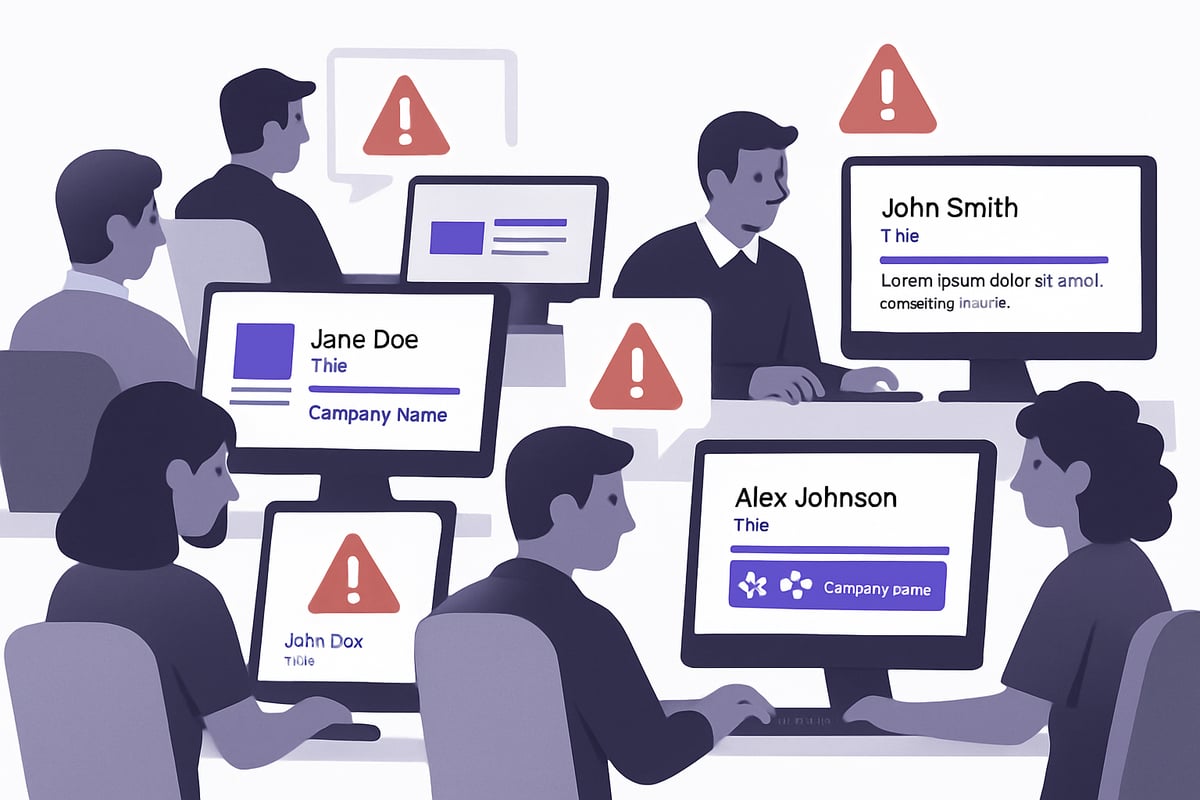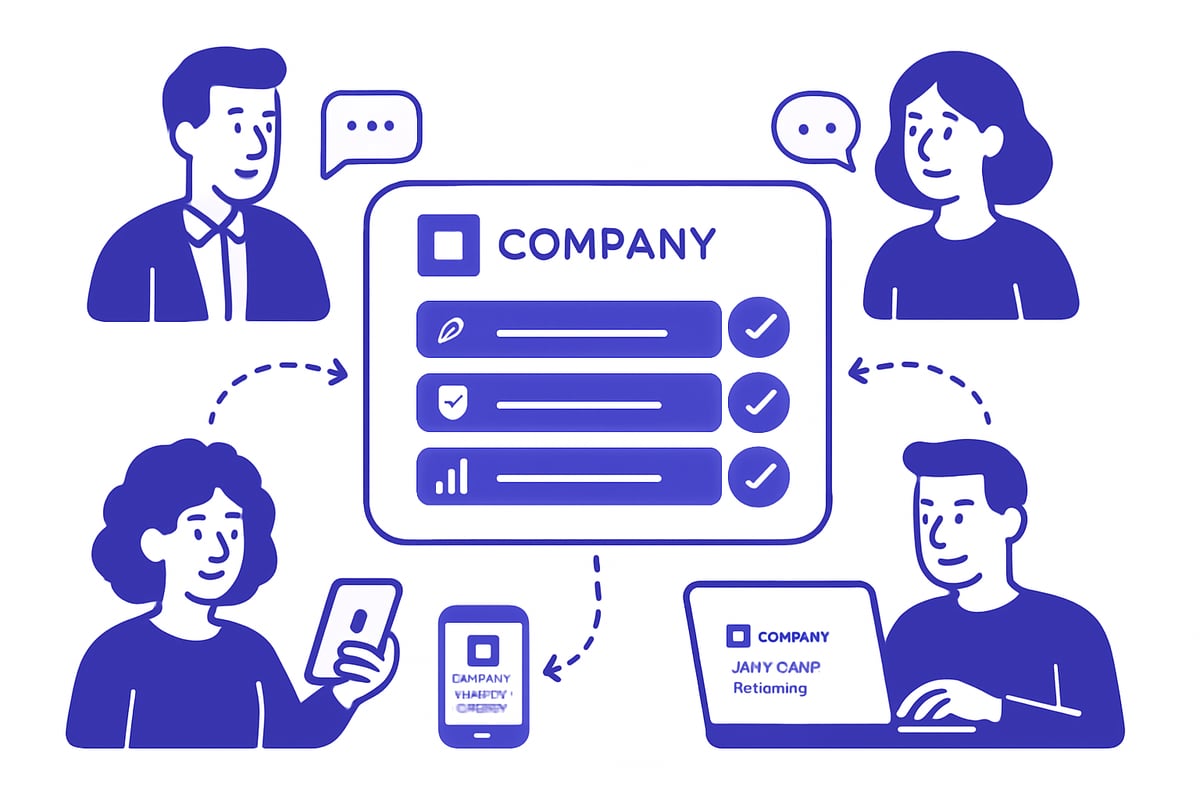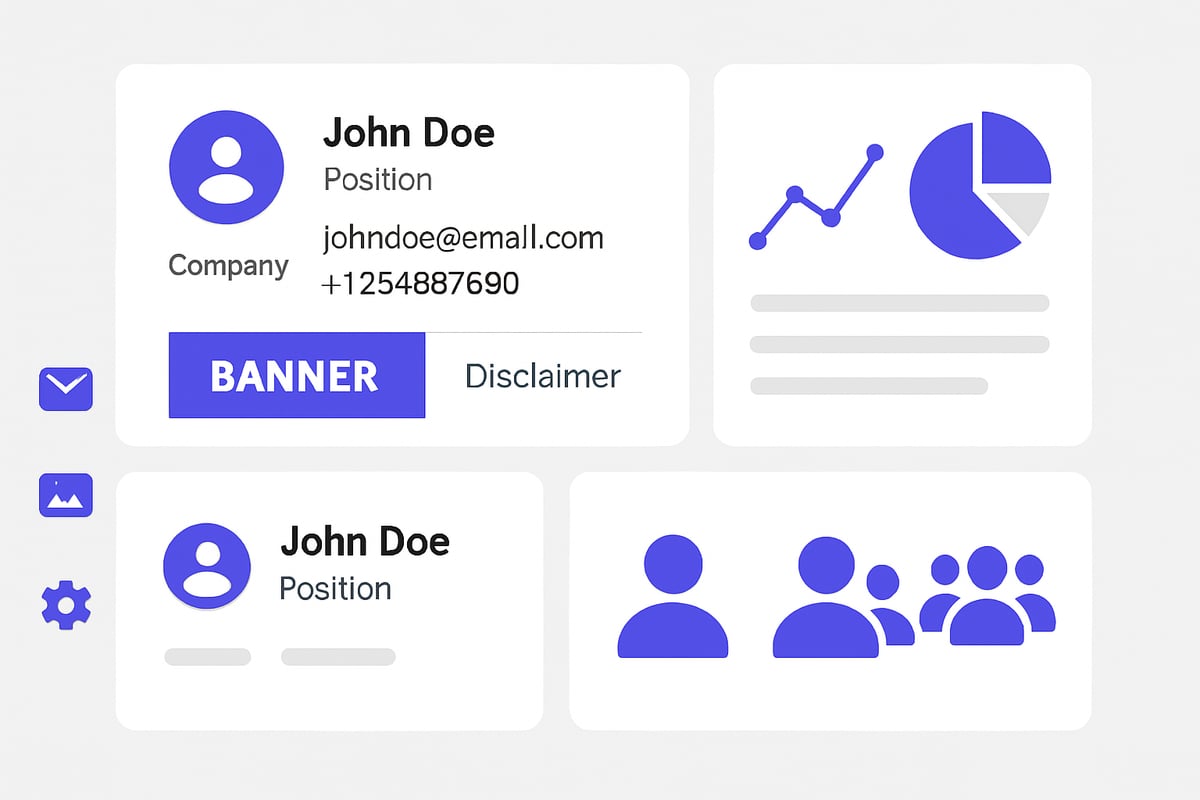The Essential Guide to Centrally Managed Email Signatures 2025
16 minutes
11th of October 2025
In this article:
- The Risks and Challenges of Unmanaged Email Signatures
- Key Benefits of Centrally Managed Email Signatures
- Essential Features to Look for in Central Email Signature Solutions
- Step-by-Step Guide: Implementing Centrally Managed Email Signatures in 2025
- Integrating Email Signatures with Business Systems and Workflows
- Future Trends in Centrally Managed Email Signatures
Outdated and inconsistent email signatures are quietly eroding your company’s credibility and putting compliance at risk in 2025. As organizations grow and regulations tighten, the need for control is greater than ever.
Centrally managed email signatures offer a powerful solution to unify branding, automate compliance, and eliminate operational headaches. This guide gives IT, marketing, and HR leaders the tools to implement, optimize, and future-proof signatures across the business.
You’ll discover the risks of unmanaged signatures, the core benefits of central management, essential features, step-by-step implementation, integration strategies, and emerging trends. Ready to strengthen your brand and reduce risk? Read on for practical guidance.
The Risks and Challenges of Unmanaged Email Signatures
Outdated, inconsistent, or poorly managed email signatures can quietly undermine your organization's reputation, security, and efficiency. Without a strategic approach, businesses expose themselves to branding confusion, legal risks, operational burdens, and lost marketing opportunities. Understanding these challenges is the first step toward adopting centrally managed email signatures.

Inconsistent Branding and Professionalism
When email signatures are left unmanaged, employees often create their own versions. This leads to a patchwork of off-brand designs, outdated logos, and inconsistent messaging across the company. Recent industry data shows that large enterprises can experience up to 70 percent inconsistency in email signatures across departments. Such discrepancies weaken your brand's visual identity and can erode customer trust. Clients may question the legitimacy of your communications if every email looks different. Centrally managed email signatures ensure that every message reflects your current brand standards.
Compliance, Legal, and Security Issues
Many industries require specific legal disclaimers and privacy statements within every outbound email. Unmanaged signatures make it nearly impossible to guarantee compliance with regulations like GDPR, HIPAA, or CASL. This exposes organizations to fines and legal action. Unauthorized or incorrect content can also trigger liability concerns and data privacy breaches. For a deeper exploration of these risks, see this overview of compliance risks in email signatures. Centrally managed email signatures automate compliance, ensuring every message meets legal standards and reduces exposure to costly incidents.
Operational Inefficiencies and IT Overhead
Without centralized control, IT or HR teams must manually update signatures for every employee. This is not only time-consuming but also prone to human error. Employees may submit repeated support requests or make unauthorized changes, further increasing the burden. According to a recent survey, 60 percent of IT managers identify signature management as a recurring challenge. Centrally managed email signatures automate deployment, drastically reducing manual work and support tickets.
Missed Marketing and Analytics Opportunities
Email signatures are a valuable channel for marketing campaigns, event promotions, and call-to-action buttons. When signatures are unmanaged, there is no consistent way to deploy banners or track engagement. This results in missed opportunities for unified messaging and data-driven marketing efforts. Centrally managed email signatures allow you to insert dynamic banners and trackable links, unlocking measurable campaign performance and A/B testing capabilities.
Loss of Control and Shadow IT
In the absence of a centralized solution, employees sometimes turn to third-party tools or custom scripts to modify their signatures. This creates security vulnerabilities and increases the risk of data leaks. Shadow IT practices make it difficult for organizations to maintain oversight and enforce policies. Centrally managed email signatures prevent unauthorized changes, ensuring IT retains full control and organizational data remains protected.
Key Benefits of Centrally Managed Email Signatures
Outdated, unmanaged email signatures create more problems than most leaders realize. In today's digital era, maintaining control over branding, compliance, and communication is non-negotiable. Centrally managed email signatures offer a comprehensive solution that empowers organizations to project professionalism, reduce risk, and streamline daily operations.

Brand Consistency Across All Communications
Centrally managed email signatures ensure that every message sent by your team reflects your current brand identity. With a single update, logos, color schemes, fonts, and layouts are synchronized across all users. This eliminates the risk of employees using outdated logos or mismatched fonts that can erode trust.
A consistent signature design strengthens your corporate image and helps customers instantly recognize your brand. It also avoids confusion when communicating with clients or partners, especially as businesses grow and onboard new team members. By using centrally managed email signatures, organizations maintain a unified voice in every email.
Legal and Regulatory Compliance Made Easy
Legal requirements for email communications are evolving rapidly. Organizations must include specific disclaimers or privacy statements to comply with regulations like GDPR, HIPAA, and CASL. Managing these manually can lead to costly mistakes.
With centrally managed email signatures, legal texts and disclaimers are centrally controlled and automatically applied based on user location or department. This reduces the risk of non-compliance and ensures every message meets regulatory standards. For more insights on how centralized signature management boosts data privacy and compliance, see Data privacy in email communication.
Enhanced Marketing and Engagement
Every email is a marketing opportunity. Centrally managed email signatures allow companies to add dynamic banners for campaigns, events, or product launches. Marketing teams can embed trackable links to measure engagement and optimize future initiatives.
According to Wisestamp, businesses experience up to a 20 percent increase in campaign engagement when using banner-enabled signatures. With the ability to schedule or rotate banners, organizations ensure that every communication supports their latest marketing goals. Central management means updates are instant and error-free.
Streamlined IT and HR Operations
Manually updating signatures for hundreds or thousands of users drains IT and HR resources. Centrally managed email signatures automate deployment through directory integrations like Microsoft Entra ID or Google Workspace. This eliminates manual errors and reduces the need for repetitive support tickets.
Automated workflows also speed up onboarding and offboarding. New hires instantly receive the correct signature, while departing employees are removed without delay. This streamlined process frees up valuable time for IT and HR teams to focus on more strategic projects.
Security and Control
Security risks increase when employees create their own signatures or use unauthorized tools. Centrally managed email signatures prevent unauthorized modifications and minimize shadow IT. Administrators control who can edit templates, ensuring only approved changes are made.
Role-based access allows marketing or HR to update specific elements without compromising security. Audit trails and version control features further protect the organization from data leaks or compliance breaches. This level of control is essential for maintaining trust with stakeholders.
Improved Employee Experience
Employees appreciate not having to worry about formatting or updating their email signatures. Centrally managed email signatures remove this burden, letting staff focus on core responsibilities. Automatic updates mean everyone has the correct contact details, branding, and legal text at all times.
Onboarding is smoother, and there is no confusion over which template to use. Offboarding is equally efficient, preventing outdated signatures from being used after someone leaves. By simplifying this aspect of communication, organizations enhance both productivity and morale.
Essential Features to Look for in Central Email Signature Solutions
Selecting the right platform for centrally managed email signatures is crucial for achieving consistency, compliance, and operational efficiency. Modern solutions offer a comprehensive suite of features designed to address branding, legal, and IT requirements across the organization.

Template Design and Customization
A robust solution for centrally managed email signatures should offer both drag-and-drop editors and HTML templates. This flexibility allows marketing teams to create branded layouts quickly, while IT can implement custom designs when needed.
Key features include:
- Support for company-approved fonts, colors, and logos
- Dynamic fields for names, roles, and departments
- Embedding social media icons and scheduling tools
These capabilities ensure every email reflects your latest brand guidelines, minimizing manual work and reducing the risk of off-brand communication.
Integration with Directory and HR Systems
Integration is foundational for centrally managed email signatures. The platform must sync seamlessly with Microsoft 365, Google Workspace, and leading HR systems. Automated data updates eliminate manual entry, ensuring that every employee’s signature stays accurate as roles or departments change.
Benefits of integration:
- Real-time updates when staff join, leave, or change positions
- Reduced human error in signature details
- Central source of truth for contact information
A well-integrated system supports scalability and compliance as your business grows.
Role-Based and Conditional Logic
Centrally managed email signatures should provide role-based controls and conditional logic. This allows organizations to tailor signatures based on department, region, or user group.
For example:
- Legal disclaimers can be applied to users in regulated industries
- Marketing banners can rotate by campaign or location
- Executives and sales staff can have distinct layouts
This targeted approach ensures compliance and relevance without manual intervention.
Centralized Control and Delegation
Centralized management is essential for consistency, but flexibility is also key. Look for solutions that feature an admin dashboard for global updates and the ability to delegate editing rights to marketing or HR teams.
Advantages include:
- One-click updates to all users
- Clear role-based permissions for editing templates
- Streamlined approval workflows
This structure prevents unauthorized changes and empowers teams to manage content within policy constraints.
Analytics and Reporting
Advanced analytics are a must-have for centrally managed email signatures. The best solutions track signature usage, banner clicks, and engagement rates in real time.
Features to expect:
- Dashboards displaying open and click metrics
- Integration with marketing analytics platforms
- A/B testing to optimize signature campaigns
According to Email signature statistics 2024, organizations leveraging signature analytics have seen measurable gains in campaign performance. This data-driven approach enables continuous improvement.
Security, Privacy, and Compliance
Security and compliance cannot be compromised. Effective centrally managed email signatures platforms include GDPR, HIPAA, and industry-specific compliance tools. Features such as audit trails and version control help organizations demonstrate regulatory adherence.
Key safeguards:
- Encrypted data storage and secure authentication
- Automated legal text updates based on user region
- Comprehensive logs of changes and access
These measures protect sensitive information and reduce legal risk.
Scalability and Multi-Platform Support
A scalable solution supports organizations from startups to enterprises. Centrally managed email signatures must work across desktop, mobile, and webmail clients to ensure universal consistency.
Important capabilities:
- Compatibility with all major email clients
- Centralized updates for thousands of users
- Support for rapid onboarding during growth
This future-proofs your investment and accommodates business expansion.
User Experience and Support
Ease of use drives adoption. Platforms for centrally managed email signatures should offer intuitive onboarding, clear documentation, and responsive support.
Look for:
- Guided setup wizards and training resources
- 24/7 customer support and knowledge bases
- Minimal disruption to employees’ daily workflow
A positive user experience ensures widespread compliance and reduces IT support requests.
Step-by-Step Guide: Implementing Centrally Managed Email Signatures in 2025
Implementing centrally managed email signatures is a strategic move that protects your brand, ensures compliance, and streamlines operations. This guide outlines how to transition your organization to a modern, unified signature solution in 2025. Follow each step to maximize impact and avoid common pitfalls.

Step 1: Assess Organizational Needs and Stakeholders
Begin by gathering input from every team affected by email signatures. IT, marketing, HR, and legal all have unique requirements for centrally managed email signatures. Identify pain points such as branding inconsistencies, compliance mandates, and operational inefficiencies.
Create a checklist of must-have features, including legal disclaimers, branding elements, and analytics. Document stakeholder goals to ensure every requirement is addressed in your project plan for centrally managed email signatures.
- Consult with IT for technical needs.
- Meet with marketing to define branding standards.
- Coordinate with HR and legal for compliance.
This collaborative approach sets a strong foundation for your centrally managed email signatures rollout.
Step 2: Choose the Right Solution
Evaluating software options is critical for successful deployment of centrally managed email signatures. Compare cloud-based and on-premise platforms, focusing on scalability, security, and integration with your current systems.
Review features such as template customization, directory sync, analytics, and compliance controls. Industry research, like the Email signature software market report, provides valuable insights into trends and vendor capabilities.
Gather demos and feedback from stakeholders to ensure the selected solution aligns with your centrally managed email signatures objectives.
Step 3: Plan Signature Templates and Branding Guidelines
Work closely with marketing to design templates that reflect your brand’s identity. Centrally managed email signatures should include consistent logos, colors, fonts, and contact details.
Define dynamic fields for personalization, such as job titles and departments. Specify required legal text, social media links, and campaign banners. Draft clear branding guidelines so every signature remains compliant and visually unified.
- List required template elements.
- Set rules for dynamic content.
- Document branding standards for centrally managed email signatures.
Step 4: Integrate with Directory and HR Systems
Connect your chosen solution to Microsoft Entra ID, Google Workspace, or your HRIS. This integration automates user data updates in centrally managed email signatures, reducing manual entry and errors.
Map directory attributes like name, role, and phone number to signature fields. Test the sync process to verify accuracy. Automated integration ensures every employee’s signature is always up to date, even during onboarding or role changes.
- Map user attributes to template fields.
- Automate updates for new hires and departures.
- Monitor integration for data consistency.
Step 5: Set Up Role-Based Rules and Conditional Logic
Leverage the platform’s role-based features to tailor centrally managed email signatures by department, location, or project. Automate inclusion of legal disclaimers for specific regions, and rotate campaign banners based on marketing initiatives.
Use conditional logic to adjust content dynamically, ensuring signatures are relevant to each recipient and compliant with regulations. This flexibility maximizes the effectiveness of centrally managed email signatures.
- Create templates for different departments.
- Set conditional rules for legal text and banners.
- Automate signature updates for special campaigns.
Step 6: Test, Pilot, and Gather Feedback
Before full rollout, deploy centrally managed email signatures to a pilot group. Collect feedback on appearance, accuracy, and user experience.
Test across devices, email clients, and platforms to verify consistency. Adjust templates and rules based on real-world feedback. This testing phase ensures centrally managed email signatures function smoothly for all users.
- Launch pilot with diverse user group.
- Gather feedback through surveys or meetings.
- Refine templates and logic as needed.
Step 7: Company-Wide Deployment and Training
Once finalized, deploy centrally managed email signatures to all staff. Communicate the changes clearly through training sessions, guides, or video tutorials.
Provide support channels for questions and troubleshooting. Ensure employees know whom to contact if issues arise. Effective onboarding ensures a smooth transition to centrally managed email signatures.
- Announce the rollout to all users.
- Offer training resources and Q&A sessions.
- Set up ongoing support for signature issues.
Step 8: Monitor, Analyze, and Optimize
After deployment, use the solution’s analytics to track engagement, compliance, and campaign performance. Regularly review reports to identify trends and opportunities for improvement in centrally managed email signatures.
Update templates for new initiatives and evolving legal requirements. Continuous monitoring and optimization help maintain branding, compliance, and operational efficiency.
- Review analytics dashboards regularly.
- Update templates and banners as needed.
- Schedule periodic audits for compliance.
Common Pitfalls and How to Avoid Them
Avoid these frequent mistakes when implementing centrally managed email signatures:
| Pitfall | How to Avoid |
|---|---|
| Excluding key stakeholders | Involve IT, marketing, HR, and legal |
| Underestimating integration complexity | Allocate time for thorough testing |
| Poor employee communication | Offer clear training and support |
| Neglecting analytics and optimization | Review metrics and update regularly |
Careful planning, open communication, and ongoing support are essential to a successful rollout of centrally managed email signatures.
Integrating Email Signatures with Business Systems and Workflows
Integrating centrally managed email signatures with core business systems unlocks powerful efficiencies and ensures your organization’s communications remain agile, compliant, and on-brand. By connecting signatures to CRM, HR, and analytics platforms, you transform a basic email footer into a dynamic business asset.
CRM and Marketing Automation Integration
Connecting your centrally managed email signatures to CRM and marketing automation tools personalizes every customer interaction. These integrations allow signatures to automatically update with campaign banners or event information, driven by real-time CRM data.
For example, sales teams can display product launch banners or unique calls-to-action based on customer segments. This approach not only increases marketing reach but also ensures messaging is always relevant.
- Automatically synchronize contact data
- Deploy event-specific banners during campaigns
- Trigger updates based on CRM workflows
HR and Onboarding Automation
Integrating centrally managed email signatures with HR platforms streamlines onboarding and offboarding. When a new employee joins, their details are synced automatically, ensuring their signature is accurate from day one.
Promotions, department changes, or departures are also reflected in real time. This reduces manual updates and eliminates outdated information, improving both efficiency and professionalism.
- Instant signature updates for new hires
- Automated removal for departures
- Consistent formatting across all staff
Security and Compliance Workflows
Security and compliance are critical for any organization. By linking centrally managed email signatures to compliance workflows, you can automate the inclusion of legal disclaimers and adapt to regulatory changes without manual intervention.
Audit trails track every change, supporting compliance with standards like GDPR or HIPAA. This reduces risk and demonstrates due diligence during audits.
- Automated legal disclaimers by region
- Change logs for compliance reporting
- Seamless adaptation to new regulations
Analytics and Reporting Integration
Integrating analytics platforms with centrally managed email signatures provides valuable insights into engagement and campaign performance. Signature clicks, banner interactions, and overall usage can be tracked and visualized in real time.
This data helps marketing teams refine their strategies and maximize ROI. For more on leveraging email analytics, consider reviewing Google Analytics Email Campaign Tracking.
- Monitor click-through rates from banners
- Feed data into marketing dashboards
- Optimize content based on real results
Real-World Examples and Case Studies
Many enterprises are already realizing benefits from integrating centrally managed email signatures with business systems. For instance, companies have seen webinar registrations increase after embedding event banners tied to CRM data.
According to Gartner, 80% of enterprises plan to connect signatures with CRM and HR tools by 2025. These integrations not only streamline workflows but also position organizations for future growth and adaptability.
By leveraging these integrations, your email signatures become a vital part of your digital ecosystem.
Future Trends in Centrally Managed Email Signatures
Staying ahead in business communication means being ready for rapid change. As technology evolves, so do the demands on centrally managed email signatures. Let’s explore the trends shaping the future of email signature management and what they mean for your organization.
AI-Powered Personalization and Dynamic Content
Artificial intelligence is revolutionizing centrally managed email signatures. AI tools can suggest banners, calls-to-action, and even legal text based on the recipient or context.
For example, AI can detect when a sales team is emailing a prospect and automatically add a relevant event banner or scheduling link. This level of personalization increases engagement and ensures every interaction feels tailored.
Dynamic content updates can be triggered in real time by marketing campaigns or news, keeping signatures fresh and relevant. As AI continues to mature, expect even deeper integration with your signature workflows.
Advanced Analytics and Attribution
The future of centrally managed email signatures is data-driven. Advanced analytics provide detailed insights into how recipients interact with your email signatures.
You can track banner clicks, call-to-action conversions, and even attribute sales or leads to specific signature campaigns. Predictive analytics will help optimize design, timing, and messaging for maximum impact.
Here’s a quick comparison of current and future analytics capabilities:
| Feature | Current State | Future Trend |
|---|---|---|
| Click tracking | Basic counts | Detailed attribution |
| Engagement heatmaps | Limited | Advanced, real-time |
| Predictive insights | Rare | Commonplace |
With these enhancements, organizations can measure ROI and adjust strategies for better results.
Enhanced Security and Zero Trust Approaches
Security is a top priority for centrally managed email signatures. Future solutions will adopt zero trust principles, requiring multi-factor authentication for editing and deploying signature templates.
Automated threat detection will identify unauthorized changes or suspicious activity. Audit trails will ensure accountability and support compliance reporting.
These improvements help organizations prevent data leaks and maintain strict control over signature content, reducing risk across all communications.
Cross-Platform and Omnichannel Integration
Modern businesses use a mix of email, messaging apps, and collaboration tools. Centrally managed email signatures are expanding to cover these diverse platforms.
Expect unified signature management across email, Microsoft Teams, Slack, and other channels. This ensures consistent branding and legal compliance, no matter where conversations happen.
Consistent branding builds trust and simplifies management for IT teams. As platforms converge, integration will become a must-have for every organization.
Sustainability and Eco-Friendly Branding
Sustainability is becoming a key message in centrally managed email signatures. Businesses use digital signatures to promote green initiatives, such as paperless workflows and eco-friendly partnerships.
Digital-first contact sharing and clear sustainability statements in signatures help reinforce your company’s commitment to the environment. According to Adobe, 65% of businesses now highlight sustainability in digital communications.
These trends not only boost brand image but also align with growing customer expectations around environmental responsibility.
Regulatory Evolution and Globalization
Compliance requirements for centrally managed email signatures are evolving rapidly. Organizations must adapt to new data privacy laws and regional regulations.
Future tools will support multilingual and region-specific templates, automatically applying the correct legal disclaimers based on user location. This reduces legal risk and supports global expansion.
Staying compliant ensures your business avoids fines and maintains trust with customers and partners across borders.
The Rise of Interactive and Media-Rich Signatures
Interactive elements are transforming centrally managed email signatures. Embedding videos, scheduling links, and forms directly within signatures increases engagement and drives lead capture.
Media-rich signatures stand out in crowded inboxes and offer new ways to connect with recipients. As technology advances, expect interactive features to become standard in signature solutions.
Embracing these innovations helps organizations maximize every email as a communication and marketing tool.
You’ve seen how inconsistent email signatures can damage your brand, complicate compliance, and waste valuable time. With a centrally managed solution, you gain control, streamline operations, and turn every email into a brand-building opportunity. If you’re ready to take the next step toward effortless, unified signatures that reflect your company’s professionalism and make life easier for IT, HR, and marketing, why not experience it firsthand? You can get started in minutes—no commitment required. Discover how simple and powerful this can be when you Try for free.






